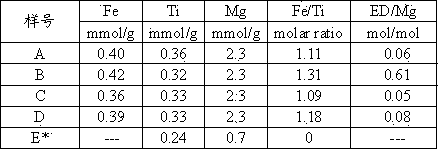Supported composite catalyst for producing high melt strength polypropylene
A high melt strength, composite catalyst technology, applied in the field of polyolefin catalysts, can solve problems such as hindering long-chain branch structures, and achieve the effects of simplifying the preparation process, saving equipment investment and energy investment
- Summary
- Abstract
- Description
- Claims
- Application Information
AI Technical Summary
Problems solved by technology
Method used
Image
Examples
Embodiment 1
[0024] (1) Prepare a carrier with internal pores of 1.5 nm, particle size of 5.0 μm, external pores of 20 nm and thickness of 20 μm using ZSM-5 molecular sieve material.
[0025] Activated carrier: Take 200 g of the carrier and dry it at 200 ℃ for 2 h under the protection of nitrogen flow, then slowly raise the temperature to 600 ℃ and continue drying for 4 h to obtain the dehydrated carrier. The dehydrated carrier was dispersed in 5 L of hexane solvent, and 0.14 mol of triethylaluminum was added, stirred at 30°C for 2 h, and then dried to obtain a treated carrier.
[0026] (2) Take 5 mmol of iron acetylacetonate and 5 mmol of bisiminopyridine ligand and dissolve them in 100 ml of toluene at room temperature. After they are completely dissolved, add 10 g of the treatment carrier, heat up to 50 ℃, and stir. Run for 4 h, wash with toluene 3 times, purge and dry with nitrogen.
[0027] (3) Take 3.0 g of magnesium dichloride, dissolve it in 200 ml of tetrahydrofuran at 60 ℃, add 1 ml of...
Embodiment 2
[0034] (1) Prepare a carrier with an internal pore channel of 1.5 nm, a particle size of 5.0 μm, an external channel of 20 nm, and a thickness of 20 μm using diatomaceous earth materials.
[0035] Activated carrier: Take 200 g of the carrier and dry it at 200 ℃ for 2 h under the protection of nitrogen flow, then slowly raise the temperature to 600 ℃ and continue drying for 4 h to obtain the dehydrated carrier. The dehydrated carrier was dispersed in 5 L of hexane solvent, and 0.1 mol of triethylaluminum (for an alkyl aluminum or alkyl aluminum oxide) was added, stirred at 70°C for 1 h, and then dried to obtain a treated carrier.
[0036] (2) The obtained treatment carrier reduces the load of the late transition metal catalyst to prepare a composite catalyst. Compared with Example 1, the addition amount of iron acetylacetonate and the bisiminopyridine ligand are both 2 mmol, and the internal electron donor is ethyl benzoate. The other catalyst preparation conditions remain unchanged...
Embodiment 3
[0040] (1) Prepare a carrier with internal pores of 1.2 nm, particle size of 4.0 μm, external pores of 30 nm and thickness of 15 μm using montmorillonite material.
[0041] Take 100 g of the carrier and dry it at 200 ℃ for 2 h under the protection of nitrogen flow, then slowly raise the temperature to 600 ℃, and continue to dry for 4 h to obtain the dehydrated carrier. The dehydrated carrier was dispersed in 5 L of hexane solvent, and 0.10 mol of triethylaluminum was added, stirred for 2 h, and then dried to obtain a treated carrier.
[0042] (2) Take 3 mmol of cobalt chloride and 3 mmol of bisiminopyridine ligand, and dissolve them in 100 ml of toluene at room temperature. After they are completely dissolved, add 10 g of the treatment carrier and raise the temperature to 50 ℃. Stir and run for 4 h, wash with toluene 3 times, and dry with nitrogen.
[0043] (3) Take 5.2 g of magnesium dibromide, dissolve it in 200 ml of ether at 60 ℃, add 1.2 ml of phenyltriethoxysilane and 1 ml of ...
PUM
| Property | Measurement | Unit |
|---|---|---|
| Particle size | aaaaa | aaaaa |
| Thickness | aaaaa | aaaaa |
| Particle size | aaaaa | aaaaa |
Abstract
Description
Claims
Application Information
 Login to View More
Login to View More - R&D
- Intellectual Property
- Life Sciences
- Materials
- Tech Scout
- Unparalleled Data Quality
- Higher Quality Content
- 60% Fewer Hallucinations
Browse by: Latest US Patents, China's latest patents, Technical Efficacy Thesaurus, Application Domain, Technology Topic, Popular Technical Reports.
© 2025 PatSnap. All rights reserved.Legal|Privacy policy|Modern Slavery Act Transparency Statement|Sitemap|About US| Contact US: help@patsnap.com



